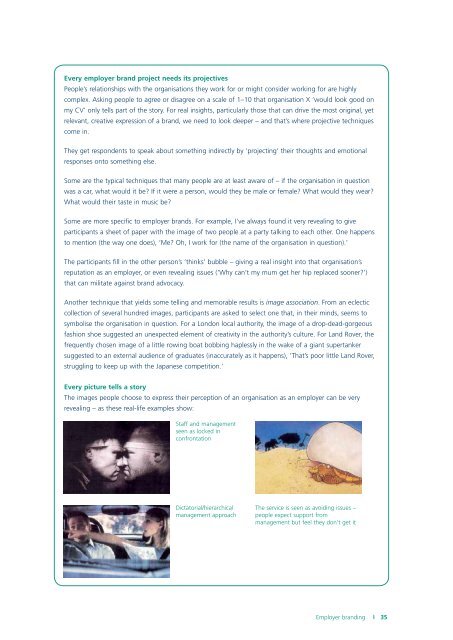Employer branding A no-nonsense approach - CIPD
Employer branding A no-nonsense approach - CIPD
Employer branding A no-nonsense approach - CIPD
You also want an ePaper? Increase the reach of your titles
YUMPU automatically turns print PDFs into web optimized ePapers that Google loves.
Every employer brand project needs its projectives<br />
People’s relationships with the organisations they work for or might consider working for are highly<br />
complex. Asking people to agree or disagree on a scale of 1–10 that organisation X ‘would look good on<br />
my CV’ only tells part of the story. For real insights, particularly those that can drive the most original, yet<br />
relevant, creative expression of a brand, we need to look deeper – and that’s where projective techniques<br />
come in.<br />
They get respondents to speak about something indirectly by ‘projecting’ their thoughts and emotional<br />
responses onto something else.<br />
Some are the typical techniques that many people are at least aware of – if the organisation in question<br />
was a car, what would it be? If it were a person, would they be male or female? What would they wear?<br />
What would their taste in music be?<br />
Some are more specific to employer brands. For example, I’ve always found it very revealing to give<br />
participants a sheet of paper with the image of two people at a party talking to each other. One happens<br />
to mention (the way one does), ‘Me? Oh, I work for (the name of the organisation in question).’<br />
The participants fill in the other person’s ‘thinks’ bubble – giving a real insight into that organisation’s<br />
reputation as an employer, or even revealing issues (‘Why can’t my mum get her hip replaced sooner?’)<br />
that can militate against brand advocacy.<br />
A<strong>no</strong>ther technique that yields some telling and memorable results is image association. From an eclectic<br />
collection of several hundred images, participants are asked to select one that, in their minds, seems to<br />
symbolise the organisation in question. For a London local authority, the image of a drop-dead-gorgeous<br />
fashion shoe suggested an unexpected element of creativity in the authority’s culture. For Land Rover, the<br />
frequently chosen image of a little rowing boat bobbing haplessly in the wake of a giant supertanker<br />
suggested to an external audience of graduates (inaccurately as it happens), ‘That’s poor little Land Rover,<br />
struggling to keep up with the Japanese competition.’<br />
Every picture tells a story<br />
The images people choose to express their perception of an organisation as an employer can be very<br />
revealing – as these real-life examples show:<br />
Staff and management<br />
seen as locked in<br />
confrontation<br />
Dictatorial/hierarchical<br />
management <strong>approach</strong><br />
The service is seen as avoiding issues –<br />
people expect support from<br />
management but feel they don’t get it<br />
<strong>Employer</strong> <strong>branding</strong>

















